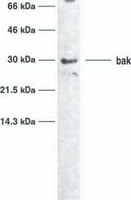AM03 Sigma-AldrichAnti-Bak (Ab-1) Mouse mAb (TC-100)
This Anti-Bak (Ab-1) Mouse mAb (TC-100) is validated for use in Immunoblotting for the detection of Bak (Ab-1).
More>> This Anti-Bak (Ab-1) Mouse mAb (TC-100) is validated for use in Immunoblotting for the detection of Bak (Ab-1). Less<<Synonyms: Anti-Bcl-2 Antagonist Killer
Recommended Products
Overview
| Replacement Information |
|---|
Key Specifications Table
| Host | Antibody Type |
|---|---|
| M | Monoclonal Antibody |
Pricing & Availability
| Catalog Number | Availability | Packaging | Qty/Pack | Price | Quantity | |
|---|---|---|---|---|---|---|
| AM03-100UG |
|
Plastic ampoule | 100 μg |
|
— |
| Product Information | |
|---|---|
| Form | Liquid |
| Formulation | In 0.05 M sodium phosphate buffer, 0.2% gelatin. |
| Positive control | HL-60 cells |
| Preservative | ≤0.1% sodium azide |
| Quality Level | MQ200 |
| Physicochemical Information |
|---|
| Dimensions |
|---|
| Materials Information |
|---|
| Toxicological Information |
|---|
| Safety Information according to GHS |
|---|
| Safety Information |
|---|
| Product Usage Statements |
|---|
| Storage and Shipping Information | |
|---|---|
| Ship Code | Blue Ice Only |
| Toxicity | Standard Handling |
| Storage | +2°C to +8°C |
| Do not freeze | Yes |
| Packaging Information |
|---|
| Transport Information |
|---|
| Supplemental Information |
|---|
| Specifications |
|---|
| Global Trade Item Number | |
|---|---|
| Catalog Number | GTIN |
| AM03-100UG | 04055977227970 |
Documentation
Anti-Bak (Ab-1) Mouse mAb (TC-100) Certificates of Analysis
| Title | Lot Number |
|---|---|
| AM03 |
References
| Reference overview |
|---|
| Chittenden, T., et al. 1995. Nature 374, 733. Farrow, S.N., et al. 1995. Nature 374, 731. Kiefer, M.C., et al. 1995. Nature 736. Reed, J.C. 1994. J. Cell Biol. 124, 1. Korsmeyer, S.J., et al. 1993. N. Semin. Cancer Biol. 4, 327. |
Citations
| Title | |
|---|---|
|
|








